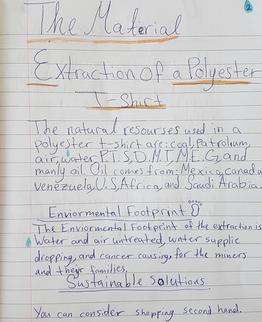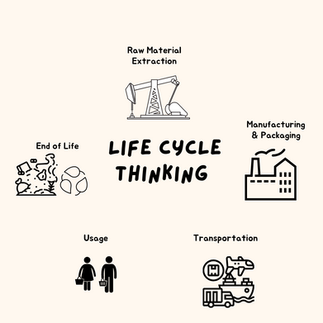Teaching the Circular Economy in the Primary Classroom
- jackieschem
- Nov 17, 2021
- 6 min read
Updated: Sep 6, 2023
What is the Circular Economy and how do we introduce the Circular Economy at the elementary age level? One way is by teaching the concepts of the circular economy through systems thinking tools such as product life cycle assessment.

School children at an early age are introduced to nature's cycles by learning about life cycles of insects and animals. Children learn how a caterpillar changes into a pupa, and then changes into a butterfly, these butterflies then lay eggs and the cycle repeats. Once children have a basic understanding of how natural cycles work you can begin to introduce product life cycles.
Understanding a product life cycle is a relatively new field of study and one that is critical to the environmental movement if we are to really understand the environmental impacts and footprint of the products that we are buying and making.
When introducing the idea of product life cycle thinking to students, start with a simple product such as a pencil. A pencil is an item that they are familiar with, that they have used multiple times, and that they might have a basic understanding of the materials that make up that item.
Ask students to map out what cycle they think the pencil goes through from the birth or creation of this pencil, the journey it took to be in their hand in the classroom, and it’s end of life. Give students a large piece of paper and encourage them to draw out the pictures and try and categorize the stages that they think this pencil goes through.
As the students are drawing and thinking about the life cycle of a pencil, start to record the questions that they begin to ask. Some of these questions may be where does rubber come from? Where does metal come from? Some students might not be able to identify the material that makes up the rubber eraser or the metal clasp that holds the eraser and that's okay. Everyone's life cycle map will be very different and some students may have included several steps and some will have few steps.

As they're drawing their life cycle maps and thinking about the pencil from birth to end of life, you can further prompt their thinking by asking them, how did the wood get to the factory to be made into that pencil? What do they think happens to the pencils when they are too small to write with?
Once each student has had time to think through the life cycle and what these possible steps could be, group several students together and have them compare their life cycle maps. Then give them a new piece of paper and allow them to reorganize and sort through their steps, add or take away steps, and ask them if they can come up with five or six names to categorize the stages of the life cycle. (This is systems mapping!)
Once each group has had time to illustrate and sort out their stages, display the posters around the room and do a gallery walk as each group is walking around the room, prompt them further by asking them what differences and similarities between the maps they notice. This lesson might take a full hour to do and it might prompt further inquiries as children aren't able to answer certain questions, such as where rubber comes from. Make sure to take time to allow your students to inquire into these questions and provide them with the tools needed to find the information.

After comparing all of the different life cycle maps, have your students come to a consensus on which five stages or six stages they think most products go through and try to label those stages. At this point you can suggest some labels for them, but usually students are able to come up with the main life cycle stages of a product on their own, and that's really what inquiry learning is all about; having them come to the conclusion on their own.
You can then keep the names if they work for you, or you can reveal the more commonly used labels when working with life cycle thinking, these stages being extraction, manufacturing & packaging, transportation, usage, and end of life. Depending what age level you're working with, the vocabulary words for these stages aren't exactly necessary if they understand the basics of what is happening in each stage of the product life cycle.
After you have finished mapping the product life cycle of a pencil, you can challenge your students by asking them to pick anything in the classroom that has no more than four different materials and see if they can make a life cycle map for that product.
Just keep practicing creating different life cycle maps and inquiring into the materials that are in our products, and keep a running list of questions that kids ask as they're mapping, or if your students have their own inquiry journals they can record their questions as they come up.
Life cycle thinking is a good provocation into a STEM design unit in which your students will be working with the Design Cycle or Engineering Cycle and may be tasked with having to design their own products.
Life cycle thinking helps students to understand the environmental impact and all the energy and resources that go into each stage of a product's life cycle. When students start to understand the resources that are used and the complexity that goes into creating something as simple as a pencil, they may be more likely to take care of the pencils that they have or that you have in the class and this is a win-win for teachers everywhere.
I don't know about you but missing pencils are always an issue in my classroom and I found after doing such a lesson with my students they did have more respect for that pencil and took care of it a little bit better. Life cycle thinking is also a good provocation activity if you would like to focus on one of those stages and really inquire into a stage such as the end of life stage.
For this particular Grade 4 unit, the summative assessment was to create a life cycle book of a product that highlighted the natural resources used within each stage of the product’s life cycle. Students then also researched steps and actions (leverage points) that can be taken to lower the environmental impact within each stage and included this information in their booklets.

Before students started their summative assessments, we inquired together into a case study that helped students develop the inquiry skills needed for them to successfully complete their summative assessment on their own topic. For our case study, we inquired into the life cycle of a cotton t-shirt, together we researched the impacts at each stage, and then together brainstormed different actions that we can take as individuals, actions that companies can take, and actions that governments can take to lower the environmental impact within each of those stages. We also brainstormed together what natural resources were used within each stage and we used little symbols on our drawings to indicate that we understood that during the manufacturing stage, for example, that water was used as well as energy or the burning of fossil fuels. By doing a case study together we were building our understanding and knowledge of the life cycle stages, actions and leverage points that can be taken. When the students started their summative assessments, they had that prior experience to build on and apply to their inquiry on their chosen product and this gave them the skills and knowledge necessary to independently research and create their life cycle booklet.
Understanding the full life cycle of how our things are made and taking the time to map it out and inquire deeper into each stage helps our student as future engineers, scientists, artists, innovators, activists, and citizens, to find those leverage points for change for the transition to a Circular Economy. The Ellen Macarthur foundation defines a Circular Economy as an economy that...
1) Eliminates Waste and Pollution
2) Circulates Products & Materials
3) Regenerates Nature

The concept of Circular Design and the Circular Economy can be challenging for younger students and by introducing them to product life cycle thinking we can help our students begin to understand why we need a transition to a Circular Economy and practice identifying those leverage points for change within a product's life cycle.
There are several ways to use product life cycle thinking in your classroom. It can be used with a unit of inquiry on recycling, composting, waste management, transportation, ethical innovation, sustainable design, natural resources, infrastructure, and so much more. Product life cycle thinking is also a great provocation to start with when inquiring into the Sustainable Development Goals, specifically, Goal 12: Responsible Production and Consumption. Be sure to check out The Story of Stuff videos and website as well as the Ellen MacArthur foundation as both offer good resources to guide your units of inquiry.
How do you introduce the Circular Economy to your students? Do you use product life cycle assessment? In what ways could you use product life cycle thinking in STEM and STEAM learning? Share some ideas in the comments below.
Looking for ready made unit plans that teach Life Cycle Assessment and the Circular Economy Design Principles? Check these out
















































Comments